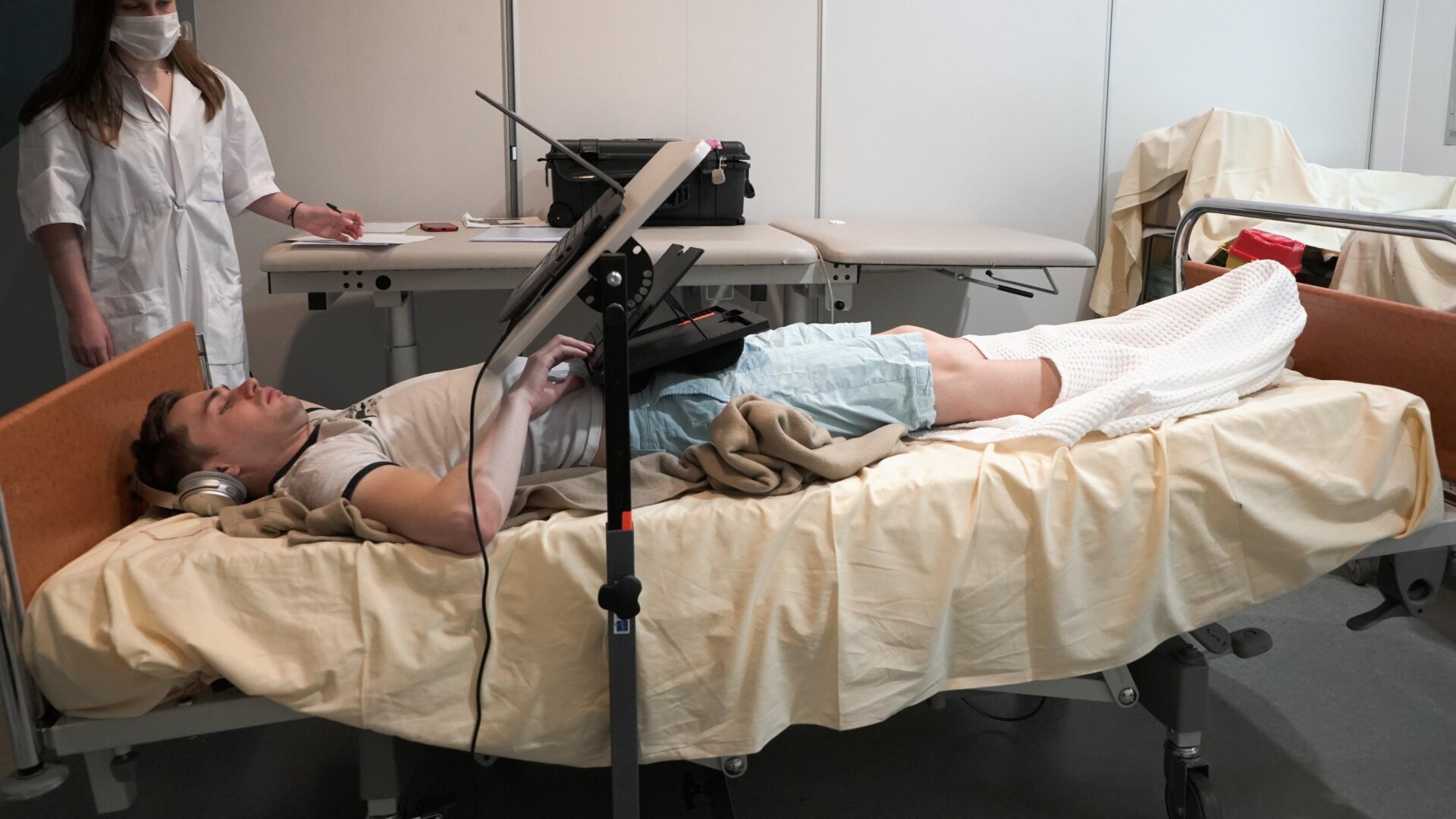Nobody knows what happens to us after death — but plenty of people believe they’ve had a sneak peek. As doctors get better and better at resuscitating people who have reached death’s door, the number of people who report having a Near Death Experience (NDE) has gone way up. One in 20 people in the United States has had one. People usually seem to come away from these things feeling comforted and spiritually engaged. By all accounts, they can be life-changing experiences.
So how do you go about having a Near-Death Experience on purpose? Apparently it’s way easier than the Joel Schumacher movie Flatliners would have you believe.
Caution: None of the techniques discussed in this article should be tried at home. The experts we talked to were very careful to point out that these are techniques that can be tried in an experimental setting, under expert assistance. DO NOT TRY ANY OF THIS STUFF ON YOUR OWN. Thank you.
Top image: Rajiv Patel/Flickr.com.
What is a Near Death Experience?
First of all, we should define our terms, and summarize what researchers appear to have found out about this increasingly common phenomenon.
It’s a misnomer, because it has nothing to do with death.
That’s right. You don’t need to be near death to have a Near Death Experience. In fact, a groundbreaking 1990 study found that out of 58 patients who reported having a Near Death Experience, only 28 were “so close to death that they would have died without medical intervention.” Writes researcher Justine Owens, “the other 30 patients were not in danger of dying, although most of them thought they were.”
“There’s almost no difference between the group that was medically in peril and the group that was not,” says Kevin R. Nelson, a neurologist at University of Kentucky. “That tells us that it’s not being near death itself necessarily, there’s another physiological trigger.” (It is true that the patients who were actually near death appeared to have somewhat stronger light effects and more “enhanced cognitive powers,” according to the study.)
They seem most common in cardiac arrest patients.
That’s the population who’s most likely to report them, says Keith Augustine with Internet Infidels. When researchers seek out populations that have spontaneously experienced NDEs, they look at cardiac arrest patients, says Augustine, who’s written a lengthy debunking of NDEs here.
It may be caused by lack of blood flow to the brain.
That’s what Nelson believes. He studied a group of 55 people (PDF) who reported Near Death Experiences, and the “proximate cause” was, in essence, that the patients blacked out. “We call it blacking out, because your vision blacks out from lack of blood flow to the brain,” says Nelson, who’s written a book called The God Impulse. “That is the most common cause.”
In fact, a German researcher, Thomas Lempert, did an experiment in the early 1990s where he caused 40 college students to faint. And he found that fainting caused similar effects to Near Death Experiences, because in both cases the limbic center of the brain was “dying.” Like near-death patients, people who fainted experienced comparable rates of out-of-body experiences, light tunnels, encounters with preternatural beings, a feeling of “peace and painlessness,” and “entering another world.” The main difference: people who fainted did not rewind their lives, nor did they glimpse the future. Image via Yhancik/Flickr.
It could be something akin to dreaming in danger.
Nelson’s own theory is that it’s not just blood loss in the brain, it’s actually something akin to what happens in REM sleep, combined with your “fight or flight” instinct kicking in. Nelson studied one of the earliest documented NDEs documented by psychologist Raymond Moody in 1975: A woman named Mrs. Martin suffered cardiac arrest, and heard her radiologist calling her physician to say that he’d killed her. She knew she wasn’t dead, but couldn’t move.
Pondering the specifics of Mrs. Martin’s condition, Nelson realized that her experience of “transient paralysis” was similar to what everyone does when we dream. The brain only has three possible states: awake, non-REM sleep, or REM sleep. Meanwhile, “there’s a strong connection between the fight-or-flight response and REM consciousness,” says Nelson. During “moments of great peril and danger,” we switch to “a blended consciousness state, one that blends REM and consciousness.”
Other explanations:
Other experts have come up with various theories to explain NDEs: they’re a psychological state in which someone regresses to childhood to protect the ego. They’re similar to a temporal lobe epilepsy. They’re a massive endorphin release, like runner’s high on a huge scale. They’re a result of blood gases. “Near Death Experience” is actually a catch-all term to refer to a number of different phenomena. And so on.
How to simulate NDE conditions Physiologically
You can most definitely have a Near Death Experience on purpose, says Nelson. It’s not even hard — although be aware that not everybody has them. Some people never have them, no matter what.
And the other good news? You don’t need to stop your heart to have an NDE. “That’s a very common misconception,” says Nelson. Your brain doesn’t know or care why it’s getting less blood flow — a cardiac arrest feels the same as a massive hemorrhage, or any other cause of blood loss. As long as you’re reducing blood flow to your brain, you have a decent chance of having an NDE.
Try fainting.
Let’s go back to Lempert’s experiments, which proved that fainting was similar to NDEs. The cause of fainting is the brain not getting enough blood flow. And it’s easy enough to make yourself faint, says Nelson:
You can do the old party trick, where you squat down and hyperventilate, and that closes the blood vessels to the brain. Then they’ll do a Valsalva [maneuver] which is breathing against their arm usually. And then stand up quickly. So if all of that is calculated to quickly reduce blood flow to the brain, then the person will faint. And with that fainting, you can have a Near Death Experience. In fact, I had one like that myself as a kid. As a lark, we induced fainting. We were playing around and did a faint, and I thought I’d had an ESP experience.
Image via Mike_tn/Flickr.
The context of the fainting may be important — because there’s that element of “fight or flight” that’s present in NDEs, which isn’t there if you’re just fainting on purpose. “If you’re facing, say, imminent danger like a wild animal about to pounce on you or someone pointing a gun at you, the circumstances of the fainting probably play into this,” says Nelson. On the other hand, if you’re trying to recreate a Near Death Experience at home, you can try fainting over and over again, and this will increase your chances.
Caution: Some of the experts we talked to for this article cautioned against making yourself faint on purpose using the Valsalva maneuver. “This is a ‘do not try this at home’ method,” says anesthesiologist G.M. Woerlee. At the very least, you should get expert supervision before you start trying to make yourself black out.
Convince a Surgeon to give you the “Standstill” procedure
If making yourself faint doesn’t work — or it’s just not hardcore enough for you — then you can try to convince a surgeon to perform the hypothermic cardiac arrest, or “standstill,” operation on you. This is a safe but fairly new operation in which the brain is deprived of blood.
Explains Augustine:
In the standstill procedure body temperature is lowered to around 60 degrees F and the heart is stopped so that blood flow to the brain can be stopped, for instance to work on an aneurysm, after which body temperature is restored. The hypothermia slows metabolism so that brain cells do not die during the procedure (severe brain damage would surely result, if not irreversible death itself, without the hypothermic conditions).
Image via Trois Têtes (TT)/Flickr.
This is a fairly safe procedure, since it’s under controlled circumstances. But obviously, draining your brain of blood is not something you really want to do on a lark. Speaking of which…
Self-asphyxiation:
Do not do this, says Nelson. Every year, “tens of kids” die from asphyxiating themselves to experience an ecstatic state of consciousness. Basically, by hanging themselves. This is incredibly dangerous, and not something anybody should be encouraging.
One drug can cause NDEs
You can’t have a Near Death Experience with a medically induced coma, says anesthesiologist Gerard Woerlee, who’s written a lot about NDEs. “Coma is a state of unconsciousness, and NDEs are definitely a state of consciousness.” But he says there is one way of inducing NDEs pharmacologically: Take ketamine, an anesthetic and animal tranquilizer.
Psychologist Karl L.R. Jansen did a huge study of “The Ketamine Model of the Near-Death Experience” in 1997. And he found that about 30 percent of people using Ketamine have NDE-like hallucinations. Writes Jansen:
I have experienced several NDEs and have also been administered ketamine as an anesthetic and within experimental paradigms. The NDEs and the ketamine experiences were very similar… Ketamine produced travel through a tunnel, emergence into the light, and a “telepathic” exchange with an entity that could be described as “God,” although I have no religious beliefs and had no particular expectations on first experiencing the drug.
But Woerlee cautions: “This is one of those ‘Don’t try this at home’ drugs.” Image via William Gibson Kiel/Flickr.
The absolute safest and easiest way to have a Near Death Experience, says Woerlee, is illustrated by this cartoon. “Scares the living daylights out of the family, too,” he adds.













